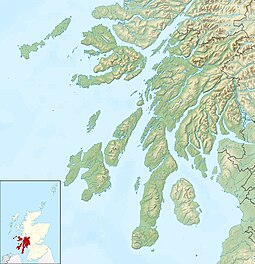Arran Island
| Gaelic name | |
|---|---|
| Norse name | Herrey |
| Meaning of name | Possibly Brythonic for "high place" |
| Location | |
|
Arran shown within the Firth of Clyde
|
|
| OS grid reference | NR950359 |
| Coordinates | 55°34′N 5°15′W / 55.57°N 5.25°W |
| Physical geography | |
| Island group | Firth of Clyde |
| Area | 43,201 hectares (167 sq mi) |
| Area rank | 7 |
| Highest elevation | Goat Fell 874 m (2,867 ft) |
| Administration | |
| Sovereign state | United Kingdom |
| Country | Scotland |
| Council area | North Ayrshire |
| Demographics | |
| Population | 4,629 |
| Population rank | 6 |
| Population density | 10.72 people/km2 |
| Largest settlement | Brodick |
| References | |
Arran or the Isle of Arran (/ˈærən/; Scottish Gaelic: Eilean Arainn pronounced [elan ˈarɪɲ]), at 432 square kilometres (167 sq mi), is the largest island in the Firth of Clyde and the seventh largest Scottish island. Historically part of Buteshire, it is in the unitary council area of North Ayrshire. In the 2011 census it had a resident population of 4,629. Though culturally and physically similar to the Hebrides, it is separated from them by the Kintyre peninsula. It is divided into highland and lowland areas by the Highland Boundary Fault and has been described as a "geologist's paradise".
Arran has been continuously inhabited since the early Neolithic period, and numerous prehistoric remains have been found. From the 6th century onwards, Goidelic-speaking peoples from Ireland colonised it and it became a centre of religious activity. During the troubled Viking Age, Arran became the property of the Norwegian crown, until formally absorbed by the kingdom of Scotland in the 13th century. The 19th-century "clearances" led to significant depopulation and the end of the Gaelic language and way of life. The economy and population have recovered in recent years, the main industry being tourism. There is a diversity of wildlife, including three species of tree endemic to the area.
...
Wikipedia

